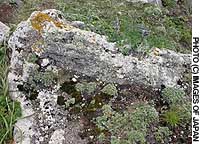A coworker of mine in the Galapagos takes great delight in corny cracks and groan-inducing jokes, but as learning aids they are indeed memorable. Take his way of teaching the partnership involved in the lichen lifestyle and where they live. With apologies to Ron Sjostedt (and whoever he gleaned it from) the story relates the meeting of two organisms, with one commenting to the other: "Algy you're such a fun guy [fungi, get it?], I think I am taking a likin' [lichen] to you; they thought it was a match made in heaven, but soon their marriage was on the rocks."
Yes, I groaned too, but the odds are you won't forget it takes two organisms -- an alga and a fungus -- to make up a lichen, and that lichen commonly occur on rocks.
"Lichen," however, is not the name of a clade of organisms, but simply a way of life for some. About 13,000 species of fungi form associations with green algae to form lichens. In contrast, no more than 40 or so different algae and cyanobacteria are known to form lichenous relationships with fungi. Thus any one of a small range of photosynthetic species may team up with one of a very wide range of fungi.
Known for their incredible ability to survive desiccation and withstand extremes of temperature, lichen are living proof that suspended animation is possible. Though they are extremely drought-resistant, most of them grow better in moist areas, and once wetted they absorb water rapidly and are soon able to resume growth.
Despite the reputation of being impervious to the elements, lichens are in fact highly sensitive in a way that makes them very important biological indicators of air quality. They tend to accumulate pollutants, which stunt their growth and deform or discolor them; only the most tolerant are able to grow near industrial areas.
I recall reading about a fascinating old study of lichens in English churchyards. The clear dating of tombstones makes it possible to trace the colonization times and growth rates of the lichens on them. By comparing the distribution and growth of lichens in urban and rural churchyards, it was possible to chart the spread and impact of air pollution across the country, making lichens a valuable visible tool for measuring invisible pollution. So you see, lichens have something in common with the fabled "perfect guy": They're tough but sensitive.
Pause beside a lichen-encrusted tree trunk, building or rock, and imagine the amazing scene unfolding before you as if in sped-up film. There is a battleground here, maybe not quite as mesmerizing as the battle scenes in "Lord of the Rings: The Two Towers," but the scope is incredible nevertheless. The skirmishes of the lichen wars, fought on tree trunks and rocks, are infinitely slow, yet they are fought on different fronts simultaneously and on different scales. The alliance between fungus and alga is an uneasy one, more like an armed truce with both sides, which maintain emphatically separate genomes, striving to keep the other in check. While uneasy together, they are united against the common enemy.
Unique chemical substances, called lichen acids, are produced in the lichen thallus, allowing them to wage chemical warfare against each other. Each colonist is in a genetically programmed race to spread out, to cover rock or trunk. Each is a solar-powered factory attempting to spread, to absorb the mineral nutrients it requires from the substrate beneath and life-giving carbon dioxide and water from the atmosphere above. Others, however, are in the same race and fighting with different chemical weapons. Each is waging war on its neighbors for territorial acquisition.
Trace a finger across this timeless battlefield and feel the difference between the three main growth forms of lichens.
There are erect dendritic forms, like miniature, shriveled trees, growing from a clear stem -- these are the fruticose lichens, and they are easily plucked from their base.
Then there are the flattened, lobed and leafy, or foliose lichens, which creep horizontally over the substrate attached by fine rootlike threads and which can be peeled away.
The third kind, the crustose lichens, have a crusty crumbling thallus that is attached inseparably to the substrate across the whole of its lower surface. Their dry surfaces look like dried mud, cracked into more or less hexagonal patches. Because of their continuous attachment they can be neither plucked nor peeled; any attempt to remove them inevitably involves breaking them apart. Their enormous textural variation would make for a fabulous tactile exhibit at an art gallery.
The extent to which we generally ignore lichens is perhaps largely due to our functional approach to the natural world: We humans have found few uses for them, and none that relate to our daily lives.
Nevertheless, northern herdsmen in the Arctic know of the significance of the larger species of the genus Cladonia, including the reindeer moss, because they serve as important fodder for semi-domesticated deer. One species, Cetraria islandica, has been used by people as food, but generally lichen have little nutritional value.
The main value of lichen to humans lies in their traditional use in the preparation of dyes. The famous litmus test -- the chemical indicator beloved of school children -- is dependent on a dye (blue in alkaline solutions and red in acid solutions), which is derived from lichen.
During medieval times lichens were used in the treatment of illness and some of the substances found in lichens have since been proven to have antibiotic properties, making them useful in the treatment of infections in wounds and burns. Perhaps, the fact that we overlook lichen is our loss.
















With your current subscription plan you can comment on stories. However, before writing your first comment, please create a display name in the Profile section of your subscriber account page.